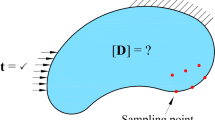Abstract
A simple and reliable technique is proposed for predicting the cartesian components of a general-displacement field from the usual double-exposure holographic fringes. An overdetermined set of simultaneous equations is developed at each point of interest and a least-squares solution provides the three displacement components. The reliability of this technique was tested by varying the degree of overdeterminacy of the set of equations. The three-dimensional displacement field of a beam under pure bending was determined holographically and compared with that from a closed-form theoretical solution. Finally, a highly skewed marine-propeller-blade model under uniform air pressure was analyzed holographically and the results were correlated with those from a finite-element analysis.
Similar content being viewed by others
Abbreviations
- A k, Bk, Ck :
-
coefficients
- H :
-
point on hologram
- P :
-
point on propeller blade
- P′:
-
displaced point on propeller blade
- R o :
-
distance betweenS andP
- R k :
-
distance betweenH andP
- S :
-
object light source
- U, V, W :
-
cartesian components of displacement
- X, Y, Z :
-
cartesian coordinates
- k :
-
subscript
- n :
-
fringe order
- σ:
-
optical-path-length difference
- λ:
-
wavelength
References
Abramson, N., “The Holo-Diagram: I. A Practical Device for Making and Evaluating Holograms, II. A Practical Device for Information Retrieval in Hologram Interferometry, III. A Practical Device for Predicting Fringe Patterns in Hologram Interferometry,” {jtApplied Optics}, {vn8} ({sn6}) ({dy1969});9, (1) (1970);9, (10) (1970).
Aleksandrov, E. B. and Bonch-Bruevich, A. M., “Investigation of Surface Strains by the Hologram Technique,” {jtSoviet Physics, Technical, Physics}, {vn12}({sn2}) (August{dy1967}).
Haines, K. A. and Hildebrand, B. P., “Surface-Deformation Measurement. Using the Wavefront Reconstruction Technique,” {jtApplied Optics}, {vn5}, ({sn4}) ({dy1966}).
Sollid, J. E., “Holographic Interferometry Applied to Measurements of Small Static Displacements of Diffusely Reflecting Surfaces,” {jtApplied Optics}, {vn8}, ({sn8}) ({dy1969}).
McCarthy, J. H. and Brock, J. S., “Static Stress on Wide-Bladed Propellers,” NSRDC Rep. 3182 (February 1970).
Boswell, R. J., “Static Stress Measurements on a highly Skewed Propeller Blade,” NSRDC Rep. 3247 (December 1969).
Dhir, S. K. and Sikora, J. P., “Holographic Displacement Measurements on a Highly Skewed Propeller Blade,” NSRDC Report 3680 (August 1971).
Timoshenko, S. andGoodyear, J. N., “Theory of Elasticity,”Second Edition, McGraw-Hill Book Co, Inc., New York (1951).
Author information
Authors and Affiliations
Additional information
The opinions expressed are those of the authors alone and should not be construed to reflect the official views of the Navy Department or the Navy Service at large.
Rights and permissions
About this article
Cite this article
Dhir, S.K., Sikora, J.P. An improved method for obtaining the general-displacement field from a holographic interferogram. Experimental Mechanics 12, 323–327 (1972). https://doi.org/10.1007/BF02320488
Issue Date:
DOI: https://doi.org/10.1007/BF02320488




